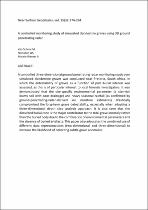 ResearchSpace
ResearchSpace
A controlled monitoring study of simulated clandestine graves using 3D ground penetrating radar
JavaScript is disabled for your browser. Some features of this site may not work without it.
- ResearchSpace
- →
- Research Publications/Outputs
- →
- Journal Articles
- →
- View Item
| dc.contributor.author |
Van Schoor, Michael

|
|
| dc.contributor.author |
Nienaber, WC

|
|
| dc.contributor.author |
Marais-Werner, A

|
|
| dc.date.accessioned | 2018-02-07T10:34:11Z | |
| dc.date.available | 2018-02-07T10:34:11Z | |
| dc.date.issued | 2017-06 | |
| dc.identifier.citation | Van Schoor, M., Nienaber, W.C. and Marais-Werner, A. 2017. A controlled monitoring study of simulated clandestine graves using 3D ground penetrating radar. Near Surface Geophysics, vol. 15(3): 274-284 | en_US |
| dc.identifier.issn | 1569-4445 | |
| dc.identifier.uri | DOI: 10.3997/1873-0604.2017007 | |
| dc.identifier.uri | http://nsg.eage.org/publication/publicationdetails/?publication=88019 | |
| dc.identifier.uri | http://hdl.handle.net/10204/10023 | |
| dc.description | Copyright: 2017 European Association of Geoscientists & Engineers. Due to copyright restrictions, the attached PDF file only contains the abstract of the full text item. For access to the full text item, please consult the publisher's website. | en_US |
| dc.description.abstract | A controlled three-dimensional ground penetrating radar monitoring study over simulated clandestine graves was conducted near Pretoria, South Africa, in which the detectability of graves as a function of post-burial interval was assessed, as this is of particular interest to local forensic investigators. It was demonstrated that the site-specific environmental parameter (a clay-rich loamy soil with poor drainage) and heavy seasonal rainfall (as confirmed by ground-penetrating-radar-derived soil moisture estimates) drastically compromised the long-term grave detectability, especially when adopting a three-dimensional depth slice analysis approach. It is also seen that the disturbed burial zone is the major contributor to the total grave anomaly rather than the buried body due to the combination of environmental parameters and the absence of buried artefacts. This paper also advocates the combined use of different data representations (two-dimensional and three-dimensional) to increase the likelihood of detecting subtle grave anomalies. | en_US |
| dc.language.iso | en | en_US |
| dc.publisher | EAGE Publications | en_US |
| dc.relation.ispartofseries | Worklist;18450 | |
| dc.relation.ispartofseries | Worklist;18416 | |
| dc.subject | Ground Penetrating Radar | en_US |
| dc.subject | GPR | en_US |
| dc.subject | Clandestine graves | en_US |
| dc.title | A controlled monitoring study of simulated clandestine graves using 3D ground penetrating radar | en_US |
| dc.type | Article | en_US |
| dc.identifier.apacitation | Van Schoor, A. M., Nienaber, W., & Marais-Werner, A. (2017). A controlled monitoring study of simulated clandestine graves using 3D ground penetrating radar. http://hdl.handle.net/10204/10023 | en_ZA |
| dc.identifier.chicagocitation | Van Schoor, Abraham M, WC Nienaber, and A Marais-Werner "A controlled monitoring study of simulated clandestine graves using 3D ground penetrating radar." (2017) http://hdl.handle.net/10204/10023 | en_ZA |
| dc.identifier.vancouvercitation | Van Schoor AM, Nienaber W, Marais-Werner A. A controlled monitoring study of simulated clandestine graves using 3D ground penetrating radar. 2017; http://hdl.handle.net/10204/10023. | en_ZA |
| dc.identifier.ris | TY - Article AU - Van Schoor, Abraham M AU - Nienaber, WC AU - Marais-Werner, A AB - A controlled three-dimensional ground penetrating radar monitoring study over simulated clandestine graves was conducted near Pretoria, South Africa, in which the detectability of graves as a function of post-burial interval was assessed, as this is of particular interest to local forensic investigators. It was demonstrated that the site-specific environmental parameter (a clay-rich loamy soil with poor drainage) and heavy seasonal rainfall (as confirmed by ground-penetrating-radar-derived soil moisture estimates) drastically compromised the long-term grave detectability, especially when adopting a three-dimensional depth slice analysis approach. It is also seen that the disturbed burial zone is the major contributor to the total grave anomaly rather than the buried body due to the combination of environmental parameters and the absence of buried artefacts. This paper also advocates the combined use of different data representations (two-dimensional and three-dimensional) to increase the likelihood of detecting subtle grave anomalies. DA - 2017-06 DB - ResearchSpace DP - CSIR KW - Ground Penetrating Radar KW - GPR KW - Clandestine graves LK - https://researchspace.csir.co.za PY - 2017 SM - 1569-4445 T1 - A controlled monitoring study of simulated clandestine graves using 3D ground penetrating radar TI - A controlled monitoring study of simulated clandestine graves using 3D ground penetrating radar UR - http://hdl.handle.net/10204/10023 ER - | en_ZA |





